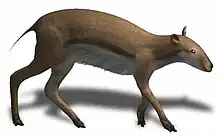| Leptomeryx | |
|---|---|
 | |
| Skeleton, Paleontology Museum of Zurich | |
| Scientific classification | |
| Domain: | Eukaryota |
| Kingdom: | Animalia |
| Phylum: | Chordata |
| Class: | Mammalia |
| Order: | Artiodactyla |
| Family: | †Leptomerycidae |
| Subfamily: | †Leptomerycinae |
| Genus: | †Leptomeryx Leidy, 1853 |
| Type species | |
| †Leptomeryx evansi | |
| Species[2] | |
| |
Leptomeryx is an extinct genus of ruminant of the family Leptomerycidae, endemic to North America during the Eocene through Oligocene 38–24.8 Mya, existing for approximately 13.2 million years. It was a small deer-like ruminant with somewhat slender body.

Mounted skeleton

L. evansi
Fossil distribution
Sites and species recovered:
- Titus Canyon, Inyo County, California (L.blacki) ~30.6—33.9 Ma.
- UNSM Sx-8 (Orella C), Sioux County, Nebraska (L. elissae) ~33.9—24.8 Ma.
- Anxiety Butte, Saskatchewan, Canada (L. sp., L. evansi) ~38—24.8 Ma.
- Calf Creek, Saskatchewan, Canada, (L. mammifer) ~38—33.3 Ma.
- Toadstool Park, Sioux County, Nebraska (L. speciosus) ~37.2—33.3 Ma.[3]
- Medicine Pole Hills, Bowman County, North Dakota (L. yoderi) ~38—33.9 Ma.[4]
References
- ↑ Webb, 1998, p. 474.
- ↑ Webb, 1998, p.471.
- ↑ Paleobiology database: Toadstool Park collection
- ↑ Paleobiology database: Medicine Pole Hills collection
- Webb, S.D., 1998. Hornless ruminants. pp. 463–476 in C.M. Janis, K.M. Scott, and L.L. Jacobs (eds.) Evolution of Tertiary Mammals of North America. Volume 1: Terrestrial Carnivores, Ungulates, and Ungulatelike Mammals. Cambridge University Press, Cambridge. ISBN 0-521-35519-2
- Heaton, T.H. and Emry, R.J., 1996. Leptomerycidae pp. 581–608 in D.R. Prothero and R.J. Emry (eds.) The Terrestrial Eocene-Oligocene Transition in North America. Cambridge University Press, Cambridge.
- Clark, John (1970-03-27). "Population dynamics of Leptomeryx". Fieldiana Geology. 16 (16): 411–451. Retrieved 2014-04-20.
This article is issued from Wikipedia. The text is licensed under Creative Commons - Attribution - Sharealike. Additional terms may apply for the media files.